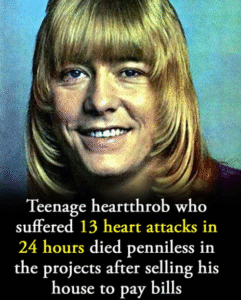It sounds like tabloid fiction—but it’s heartbreakingly real. The story of David Cassidy, the 1970s teenage heartthrob who once had more fan club members than Elvis and The Beatles combined, is a cautionary tale of fame, fragility, and the unforgiving nature of celebrity. His final years were marked by financial ruin, deteriorating health, and a haunting medical episode: 13 heart attacks in 24 hours. And when he died in 2017, he was penniless, living in a modest apartment after selling his house to pay bills.
Let’s rewind the tape and explore the full arc—from glittering stardom to tragic collapse.
🎸 The Rise: From Sitcom Star to Global Idol
David Cassidy was born into showbiz royalty. His father, Jack Cassidy, was a Broadway star; his mother, Evelyn Ward, an actress. But it was David who captured the world’s attention when he starred as Keith Partridge in The Partridge Family, a musical sitcom that aired from 1970 to 1974.
With his shaggy hair, boyish charm, and velvet voice, Cassidy became the ultimate teen idol. At the height of his fame:
- He sold out Wembley Stadium six times in one year.
- His fan club reportedly surpassed those of Elvis and The Beatles.
- He had multiple chart-topping hits, including “I Think I Love You” and “Daydreamer.”
Cassidy wasn’t just famous—he was frenzied. Girls fainted at his concerts. His posters wallpapered bedrooms. He was the face of a generation’s longing.
But behind the scenes, Cassidy struggled with the weight of fame. He wanted to be taken seriously as a musician, not just a teen pin-up. That tension would follow him for the rest of his life.
🍷 The Fall: Addiction, Bankruptcy, and Isolation
As the spotlight dimmed, Cassidy’s personal demons grew louder. He battled alcoholism for decades, with multiple stints in rehab and arrests for DUI. His relationships were turbulent—three marriages, two children, and long stretches of estrangement.
Financially, things unraveled. Despite selling over 30 million records, Cassidy filed for bankruptcy in 2015. He sold his Florida mansion for $2 million, but the money vanished into debts and medical bills. By the time of his death, he was living in a rented apartment in Fort Lauderdale, with little to his name.
Cassidy once said, “I used to be rich. Now I’m not.” The irony was cruel: the man who sang about love and dreams died with neither.
❤️ The Final Collapse: 13 Heart Attacks in 24 Hours
In November 2017, Cassidy was rushed to the hospital with organ failure. His liver and kidneys were shutting down. But what stunned doctors was the sheer violence of his heart’s decline: 13 heart attacks in 24 hours.
This wasn’t metaphorical heartbreak—it was physiological catastrophe. His body, ravaged by years of alcohol abuse and stress, simply couldn’t hold on.
Cassidy was placed in a medically induced coma. Fans around the world held their breath. But on November 21, he died at age 67.
His daughter, actress Katie Cassidy, later revealed his final words: “So much wasted time.” It was a devastating epilogue to a life that had once seemed limitless.
🧠 Fame’s Double-Edged Sword
Cassidy’s story isn’t unique—but it’s emblematic. The machinery of fame often chews up its brightest stars. The pressure to perform, the loss of privacy, the commodification of identity—it’s a cocktail that many can’t survive.
Cassidy was adored, but he was also trapped. He once said, “I wasn’t really prepared for fame. It was like being in a snow globe—everyone watching, everything magnified.”
His attempts to reinvent himself as a serious musician were often dismissed. The industry wanted the teen idol, not the artist. That rejection fueled his descent.
🏚️ Dying in the Projects
The phrase “died penniless in the projects” is stark. Cassidy didn’t die in literal public housing, but he did die broke, in a modest rental far from the mansions and limousines of his youth. He had sold his home to pay bills. His estate was valued at just $150,000—mostly in assets that would be consumed by debt.
It’s a sobering reminder: fame is not fortune. And fortune is not forever.
🕯️ Legacy and Lessons
Despite the tragedy, Cassidy’s legacy endures. His music still plays. His image still evokes nostalgia. And his story offers lessons:
- Financial literacy matters, even for celebrities.
- Mental health and addiction must be addressed, not hidden.
- Fame is not fulfillment—and chasing it can leave you empty.
Cassidy’s final words—“so much wasted time”—echo like a warning. But they also invite reflection. What do we value? What do we chase? And what do we leave behind?
🎤 Final Reflections
David Cassidy’s life was a symphony of highs and lows. He was adored, then abandoned. Rich, then ruined. Alive in the hearts of millions, yet ultimately alone.
But he was also human. Flawed, gifted, and searching. And in that humanity, we find connection.
His story isn’t just about celebrity—it’s about all of us. About the dreams we chase, the demons we battle, and the time we waste.
So let it be a reminder: to live fully, love deeply, and never let the spotlight blind us to what truly matters.
If you’d like, I can explore other fallen stars whose stories mirror Cassidy’s, or dive deeper into the psychology of fame and its toll. Just say the word.


